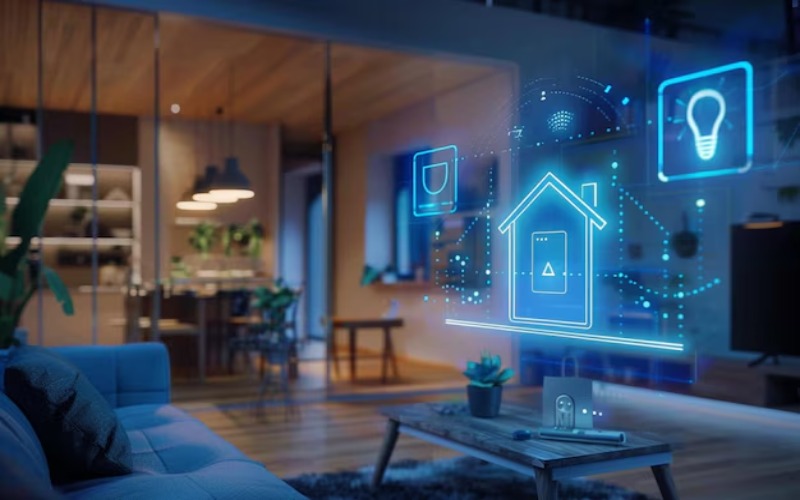In recent years, several smart home innovations have hit the market. These connected systems not only streamline everyday processes, but have also taken home security to a higher level. The days of securing your home with traditional alarms and locks may be long gone. Fully automated surveillance solutions with a “set it and forget it” feature are now all the rage.
With smart systems evolving faster than ever, it’s exciting to see what’s next in home security technology. Discover the latest advanced home security and emergency features you should prioritize.
1. Smart outdoor cameras
24/7 surveillance is an essential part of any digital home security system. However, not all cameras are created equal. The best cameras have wide-angle lenses with a 180-degree field of view to cover a larger area of the property with a panning motion and eliminate blind spots.
They also feature high-resolution image capture technologies to identify faces, license plates and other important details for improved surveillance. Night vision features ensure that image quality is not compromised regardless of the time of day.


2. Motion detection and tracking
Intelligent tracking features add an extra layer to your home security system by instantly alerting you to any movement within the camera’s field of view. These systems can often distinguish between people, animals and vehicles, reducing false alarms.
Modern cameras can also track suspicious activity and keep the object in focus even if it moves. This feature is handy for monitoring specific areas such as entrances and exits around your home. You can adjust the camera’s alarm sensitivity and set it to trigger predetermined actions, such as turning on flashing lights when the object reaches a certain area.
3. Smart locks
Although quite effective, traditional locks are becoming less and less effective against the sophisticated schemes of today’s criminals. Smart lock technologies introduce an additional level of complexity that must be resolved before they can access your property. Biometric authentication features such as fingerprint scanning, facial recognition and voice activation offer improved security and convenience.
You can also control the locks remotely via your smartphone, allowing you to manage access from anywhere. For example, if the pet sitter is coming and you’re not home, you can unlock the front door without being physically present.
4. Real-time threat monitoring
Emergency notification systems are becoming increasingly common in residential security infrastructure. These smart home innovations leverage Internet of Things technologies to provide real-time monitoring and alert you to various threats such as fires and floods.
For example, during severe flooding, a digital sensor in your basement can track intruders and notify you immediately when the water reaches a certain level. In such emergencies, the faster you know about them, the more effectively you can respond.
5. AI-powered security
The integration of AI makes smart systems smarter. For example, it can be annoying to receive an alert every time your kids or pets accidentally trigger the motion detector. AI’s powerful data analysis capabilities can improve pattern recognition and behavior tracking, allowing the security system to better distinguish between real threats and harmless situations. This feature minimizes the frequency of false alarms and improves the efficiency of emergency response teams.
Securing your smart home innovations
Ironically, your home security technology needs protecting too. Modern systems cost between $200 and $2,000 for wireless devices and up to $1,600 for wired installations. There is a well-stocked market for these items, making them attractive to threat actors. Consider these tips to protect your devices and improve your overall security posture:
- Restrict access to devices: Place your cameras and sensors in places that are not easily accessible to unauthorized persons, such as high up or behind furniture.
- Reinforce your doors: Experts recommend installing 3-inch or longer screws in your exterior doors to make it more difficult for burglars to remove the door and break in.
- Check the systems regularly: Check your smart devices regularly for signs of physical damage, tampering, or unusual wear and tear.
- Hide wires and cables: Thieves don’t have to physically damage a home security device to disable it—they can simply cut the cable. In fact, this might be an easier way to disable the system. Keep all cables out of sight and reach.
- Follow cybersecurity best practices: There are 46 internet-connected devices in the average home, and any one of them can be an entry point for hackers. Because of their interconnectedness, an infected device directly impacts all other connections on the network. You should now know that as a minimum, you need to change default passwords for your smart home systems, enable two-factor authentication, and secure your Wi-Fi network.
Improve security with smart home innovations
From advanced surveillance to real-time threat monitoring to adaptive ML algorithms, leveraging new forms of home security technology can simplify your daily life. And more importantly, it complements existing security mechanisms and provides additional protection and peace of mind.

